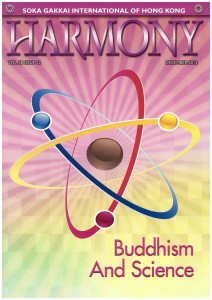HARMONY-December 2013
Thu, 5th Dec 2013
Category: Harmony, News (All), Publication
We are happy to announce that the SGI has just launched a new website, the Nichiren Buddhism Library. The SGI has made available on-line The Writings of Nichiren Daishonin, volumes I and II, The Lotus Sutra and Its Opening and Closing Sutras, The Record of the Orally Transmitted Teachings, and, as a reference to assist with study of these works, The Soka Gakkai Dictionary of Buddhism. All five of these books can now be found in searchable format at www.nichirenlibrary.org.
This month we look at the relationship between Buddhism and science.
With a seeking mind for finding truth, scientists have raised questions about the validity of religion from the very beginning of their academic research and it often appears that science and religion take diametrically opposing views. Religion is largely requiring a faith-based trust, and science demands actual proof of the stated findings, making it appear that they will never agree or find common ground.
Buddhism is one of my favorite subjects in which to engage in a meaningful, thought provoking, and sometimes heated dialogue. In my almost 30 years of chanting, I have had discussions with so many interesting people from diverse backgrounds. Each person I talked with was shaped by their unique experience in life that gave them a different view and perspective. Based on their culture and religious tradition, they had varying degrees of understanding and openness to views other than their own.
Each individual has different ways of receiving and learning new information. Some, when I tell them that they have the Buddha nature and that by chanting Nam-myoho-renge-kyo they can overcome anything, start chanting that very day. Others have been more cautious and skeptical and demand that I “prove it”. So, to demonstrate the validity of chanting I relate one of my many personal experiences of the benefits of this Buddhism, or I share those of others.
There are those who ask me to explain the workings of Buddhism in scientific terms. Some analytical people want to see empirical data and evidence to support the concepts of Buddhist philosophy before they will embrace it. That’s great. I tell them that over 12 million people in 192 countries and territories wouldn’t be chanting if it weren’t beneficial. Faith in this Buddhism is not blind faith. Buddhism encourages a practitioner to have a seeking mind, and based on practice and study, faith develops and deepens with time. But we have to take action and chant ourselves to experience it. Theory alone is not enough. For example, reading the user manual does not give us the experience of what it feels like to drive a car.
The great thing about Nichiren Daishonin’s Buddhism is that it is very logical and practical in its approach. Science is just starting to embrace theories and arrive at the same conclusions that Buddhism has been expounding for thousands of years. From the micro to the macro, from cells to the vastness of the universe, Buddhism covers it all.
As you will read in our special features and viewpoints, Buddhism and science actually do agree on many levels!
Skip Williams
Quotes of the Month:
“Science is based on tested proof or empirical evidence. You conduct a test or experiment and then observe the results. Nichiren Daishonin’s Buddhism, similarly, teaches that nothing beats actual proof. In this regard, it stands alone among world religions.” —Daisaku Ikeda, FIA p.4

